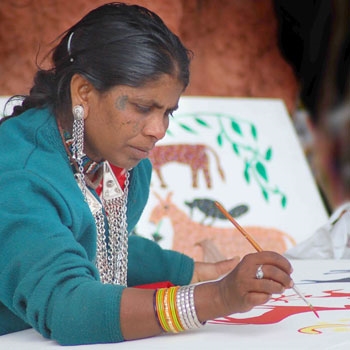Ladoo Bai | Ladoo Bai Bio
Ladoo Bai, who is in her late 50s, was identified as a potential artist by J Swaminathan during his research tours through the tribal districts of Madhya Pradesh. She packs her paintings densely, encrypting them with trees and animals, some of which have a symbolic significance. Among these, she fits in occasional human beings who have been scaled down in relation to nature, although they are hunters and cultivators who could bring down the edifice of the natural with a few cataclysmic gestures. The effect of her orchestration of image-density is to communicate a bursting fullness of regenerative power.
Ladoo Bai develops her figures as if through layers of embroidery: sometimes, she allows the trailing branches of a tree to form a partial border around her ensemble of motifs. She revels in a dynamic asymmetry between details that are refined to completion, and details deliberately left brushy and unfinished. Many of her paintings are composed around a dance of stags and antelopes, tree goddesses and herons, snakes and hunters, turtles and riders. Certain forms that fascinate her, including the stylised standing hero, the rayed or wheel-like sun, and the dance of the animals, may be traced back to the Late Stone Age. Such images are to be found, for instance, in the Bhimbetka caves in Central India. Their persistence in Ladoo Bai’s work may spring from a genealogical or ascribed continuity of ritual imagery, but may also come from the exposure of such artists to archaeological studies and historical exhibitions.
